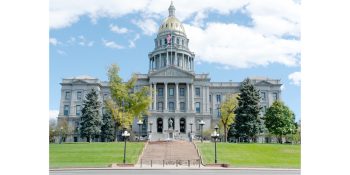Jan. 27 – Gathered to recognize our armed forces, members of the General Assembly today honored Coloradans who have served our country. As chair and vice chair of the House State, Veterans and Military Affairs committee, Reps. Mike Foote, D-Lafayette, and Susan Lontine, D-Denver, were instrumental in organizing this year’s day of appreciation.
With veterans, reservists and active-duty military personnel watching on the House floor and in the gallery, members of the House and Senate came to the well to recognize the sacrifice of all those who have served and remind all Coloradans of our continuing responsibility to support our veterans.
Rep. Dafna Michaelson Jenet, D-Commerce City, told the story of her own military family—her grandfather, father, husband, son and daughter who have all served their country.
“We believe that service to this country is paramount, whether we are refugees, whether we are immigrants, or whether we are born to this country with all the beautiful freedoms that our ancestors allotted us,” said Rep. Dafna Michaelson Jenet, D-Commerce City. “And to the men and women who have served, my incredible and undying gratitude to you for your service and the freedoms that you have won for us. My family serves with you.”
“Several members of my family served in our armed forces, including my father, both grandfathers, and a great-uncle,” said Rep. Mike Weissman, D-Aurora. “Our service members all make commitments and sacrifices on many levels—from time away from family, to combat injuries, both visible and those less so—and I hope that we honor those sacrifices of our armed forces and veterans by living up to the ideals and values that they served to protect.”
“It’s a wonderful thing to recognize the sacrifices of our men and women who have served our country,” said Rep. Tony Exum, Sr., D-Colorado Springs. “It was an honor to be able to recognize my dear friends this morning on the House floor and be able to thank them for all they have done to defend our freedom.”
Approved by voice votes were these resolutions:
· HJR17-1005, sponsored by Rep. Mike Foote, D-Lafayette; Rep. Kim Ransom, R-Littleton; Sen. Vicki Marble, R-Fort Collins; and Sen. Minority Leader Lucia Guzman, D-Denver, recognizing Military, Veterans, and MIA/POW Appreciation Day.
· HJR17-1006, sponsored by Rep. Daneya Esgar, D-Pueblo; Rep. Clarice Navarro, R-Pueblo; Sen. Leroy Garcia, D-Pueblo; and Sen. Bob Gardner, R-Colorado Springs, commemorating the U.S.S. Pueblo, a surveillance ship that was captured by North Korea in 1968.
· HJR17-1007, sponsored by Rep. Tony Exum, D-Colorado Springs; House Minority Leader Patrick Neville, R-Castle Rock; Sen. Daniel Kagan, D-Cherry Hills Village; and Sen. Larry Crowder, R-Alamosa, recognizing 100 years of service by the 4th Infantry Division.
· HJR17-1008, sponsored by Rep. Pete Lee, D-Colorado Springs; Rep. Jim Wilson, R-Salida; Sen. Michael Merrifield, D- Colorado Springs; and Sen. Kent Lambert, R-Colorado Springs, recognizing the 150th anniversary of Canadian self-rule and Colorado’s relationship with Canada through the North American Aerospace Defense Command.
· HJR-1009, sponsored by Rep. Dafna Michaelson Jenet, D-Commerce City; Rep. Dave Williams, R-Colorado Springs; Sen. Chris Holbert, R-Parker; and Sen. Rachel Zenzinger, D-Arvada, commemorating the 75th anniversary of the attack on Pearl Harbor.
· HJR17-1010, sponsored by Rep. Susan Lontine, D-Denver; Rep. Yeulin Willet, R-Grand Junction; Sen. Owen Hill, R-Colorado Springs; and Sen. Nancy Todd, D-Aurora, recognizing the defense industry in Colorado.
· HJR17-1011 sponsored by Rep. Terri Carver, R-Colorado Springs; Rep. Mike Weissman, D-Aurora; Sen. Kent Lambert, R-Colorado Springs; Sen. Rhonda Fields, D-Aurora, commemorating the 35th anniversary of the United States Air Force Space Command.
· HJR17-1012 sponsored by Rep. Steve Lebsock, D-Thornton; Rep. Lang Sias, R-Arvada; Sen. Kevin Grantham, R-Canon City; and Sen. Kerry Donovan, D-Vail, recognizing the service of Coloradans who have served in the fight against terrorism and honoring those who have died for the cause of freedom.




